
At first glance, the San Leandro High School teacher thought he was looking at a memory stick inserted into the USB port on the Chromebook. But a closer look revealed it to be a vaping device recharging in the school’s computer.
In school hallways, bathrooms and even classrooms, vaping has become commonplace, say school employees. And it does not appear to be going out of fashion any time soon.
Vaping is a practice where battery-operated devices heat nicotine-laced liquid to generate an aerosol that’s inhaled. Unlike tobacco, vaping has a sweet smell that dissipates quickly. Because the most popular devices are small, discreet and easy to use, a student taking a puff in a bathroom, hallway or classroom may escape notice.
The smell may be pleasant — with flavors like mango, cotton candy and sour patch — but the side effects are anything but. Vaping is harmful to health and extremely addictive. Studies show that high levels of nicotine have a dramatic impact on developing brains. Vaping, which also includes products that use THC, the high-inducing chemical in cannabis, has been linked to at least 23 deaths in 17 states. More than 1,000 people have developed lung problems as a result of vaping. Devices have exploded in users’ hands, faces and pockets, causing disfigurement.

“A lot of students think it’s harmless, but they are taking dangerous chemicals into their bodies,” says San Leandro High School’s Tobacco-Use Prevention Education (TUPE) coordinator Dave Mason. (While vaping is not tobacco, schools can use funding from California’s Tobacco Surtax Fund to educate students about its dangers.)
Mason prefers to call it “aerosoling” rather than vaping. He tells students it’s like inhaling hair spray into your lungs, not water vapor. The San Leandro Teachers Association member is an adviser to junior “peer educators” who spread the word about the harmful effects of vaping. Through TUPE, they have created public service announcements and PowerPoint presentations.
“ I REALLY THOUGHT THIS WOULD BE THE GENERATION TO BEAT TOBACCO. BUT THEY PULLED THE WOOL OVER EVERYBODY’S EYES IN A NEW GENERATION.”
— Dave Mason, San Leandro Teachers Association
“They’ve gone into freshman classes to present, and I think they are making a difference,” says Mason, a social studies teacher. The teens are also educating staff about vaping devices and what they look like, so educators can recognize telltale signs. They visit other high schools to share strategies.
“It’s important that we do this, because the media tends to normalize vaping,” shares peer educator Rosemary Che, who points out that pods inserted into vaping devices may have two or three times the nicotine level of one pack of cigarettes. “Some students say they vape to relieve stress, but there are better ways — such as power naps and meditation.”
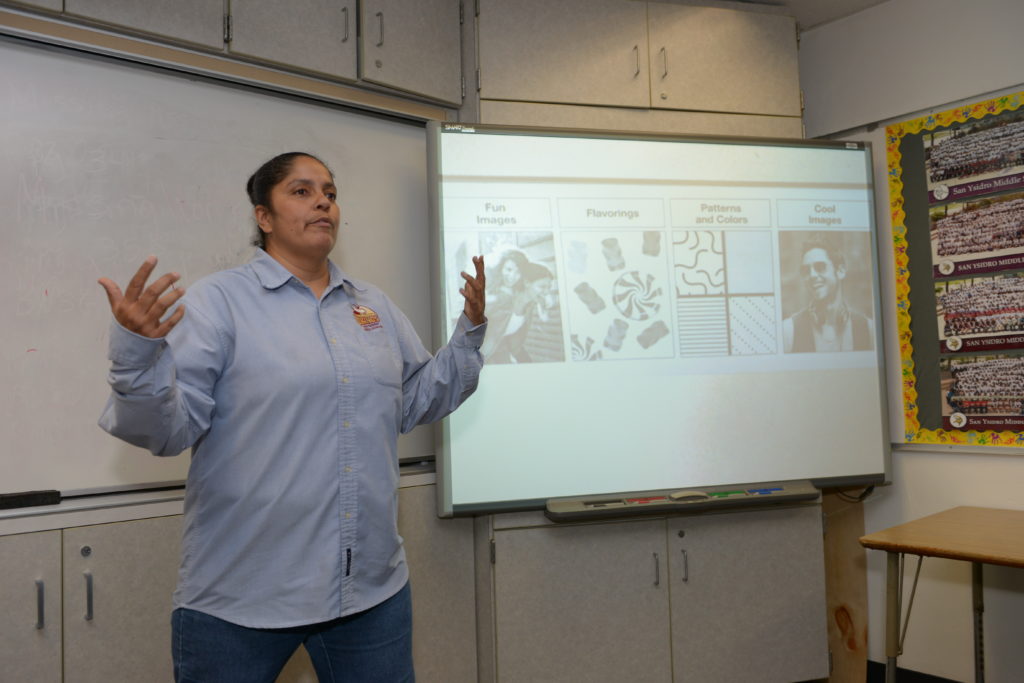
“I TELL STUDENTS THAT WHEN SOMETHING NEW COMES ABOUT THAT LOOKS FUN AND FANTASTIC, THEY NEED TO BE CAUTIOUS AND RELY ON REAL INFORMATION INSTEAD OF WHAT THEIR FRIENDS SAY.” — Michelle Patterson, San Ysidro Education Association
Michelle Patterson shows vaping ads to her class.

Abigail Jauregui’s survey of her fellow students showed that many were unaware of vaping’s dangers.
Peer educator Patrick Campana became involved because his grandfather died from lung cancer related to smoking. Students rarely smoke cigarettes these days, he observes, but they are all about vaping. He explains to his fellow students that vaping can result in “popcorn lung,” a life-threatening condition where the lungs’ smallest airways become inflamed and damaged, causing coughing and shortness of breath.
Mason is proud to be pushing back against what he sees as a vile and addictive habit that caught educators by surprise. “I really thought this would be the generation to beat tobacco. But they pulled the wool over everybody’s eyes in a new generation.”
Teen Vaping Soars
Data from the U.S. Centers for Disease Control and Prevention show a staggering 78 percent increase in high school youth vaping between 2017 and 2018. Vaping among America’s teens continues to climb while the use of other substances, such as alcohol and opiates, has declined in recent years, according to “Monitoring the Future,” a report from the University of Michigan. (A 2017 survey by the CDC found nearly 7 million adults 18 or older use e-cigarettes.)
According to a December 2018 survey by California Healthline, U.S. teens are vaping in record numbers. More than one-third (37.3 percent) of 12th graders reported vaping at least once in the past month — up 10 percentage points from 2017.
The number of teens who took up vaping increased when Juul, an e-cigarette resembling a flash drive, became available and was widely advertised in 2017. Juul Labs says the product is intended for smokers trying to quit; its actions indicate otherwise.
In July, hearings by the House Oversight Subcommittee on Economic and Consumer Policy revealed that Juul Labs spent hundreds of thousands of dollars to fund youth programming. Democratic members of the subcommittee investigating Juul’s role in the youth vaping epidemic found the company “deployed a sophisticated program to enter schools and convey its messaging directly to teenage children.” In one case, Juul Labs paid $134,000 to sponsor a five-week “holistic health education” summer camp in Baltimore that “recruited from grades 3 through 12.” Juul’s plans also included paying $10,000 to high schools that would “use the Juul-sponsored curriculum” during classes.
While you must be 21 to purchase vaping equipment in California, teens are able to obtain products easily. In fact, Breathe California reports, 93.8 percent of students are successful when ordering vaping products online.
After the sixth death linked to vaping in September, the Trump administration announced plans to ban flavored e-cigarettes. California’s Department of Public Health has issued a “stop vaping” advisory. Meanwhile, laws to restrict vaping are making their way through the state Legislature. Senate Bills 38 and 39, sponsored by Sen. Jerry Hill (D-San Mateo), would ban the sale of flavored tobacco and e-cigarette products in stores and vending machines and make them more difficult to buy online. Twenty-five cities or counties in California have restricted the sale of these products. (The bills would not affect the sale of unflavored e-cigarette products.)
Health experts fear that the high concentration of nicotine in vaping liquids can be extremely addictive for teens. Nicotine is known to raise blood pressure, is linked to heart disease, and affects brain development. The heated e-liquids damage lungs, too. There are still many unknowns about the long-term effects of vaping.
Not surprisingly, tobacco companies are investing in e-cigarette companies. Altria, the company behind Marlboro cigarettes in the United States, spent $12.8 billion in 2018 to purchase a 35 percent minority stake in Juul Labs. (Recently, Altria introduced a new product that heats rather than burns tobacco; it claims to give users a nicotine rush with fewer toxins.)
Educating students
Michelle Patterson, a science teacher at San Ysidro Middle School, which overlooks Tijuana, is presenting a slide show to her eighth grade class of primarily Latino students. The slides are of advertisements showing happy, attractive young people vaping candy, dessert and fruit flavors — even chamoy, a sweet and salty Mexican condiment.

Her students know that these ads, which they see on YouTube and other websites and in stores, are aimed directly at them. “These kids are ripe for advertising, so it’s important to teach them early,” says Patterson. “Last year, a fifth-grader brought a vaping device to school with flavored nicotine.”
The San Ysidro Education Association member asks students what these messages imply, and they tell her that it makes vaping look fun and healthy.
“Do you consider these ads to be a reliable source of information?” asks Patterson. “Do the ads show you what’s really in the product? Does it show you how vaping could affect your heart, lungs and brain? Does it show you that your tongue could turn black and that it could affect how you learn and remember things?”
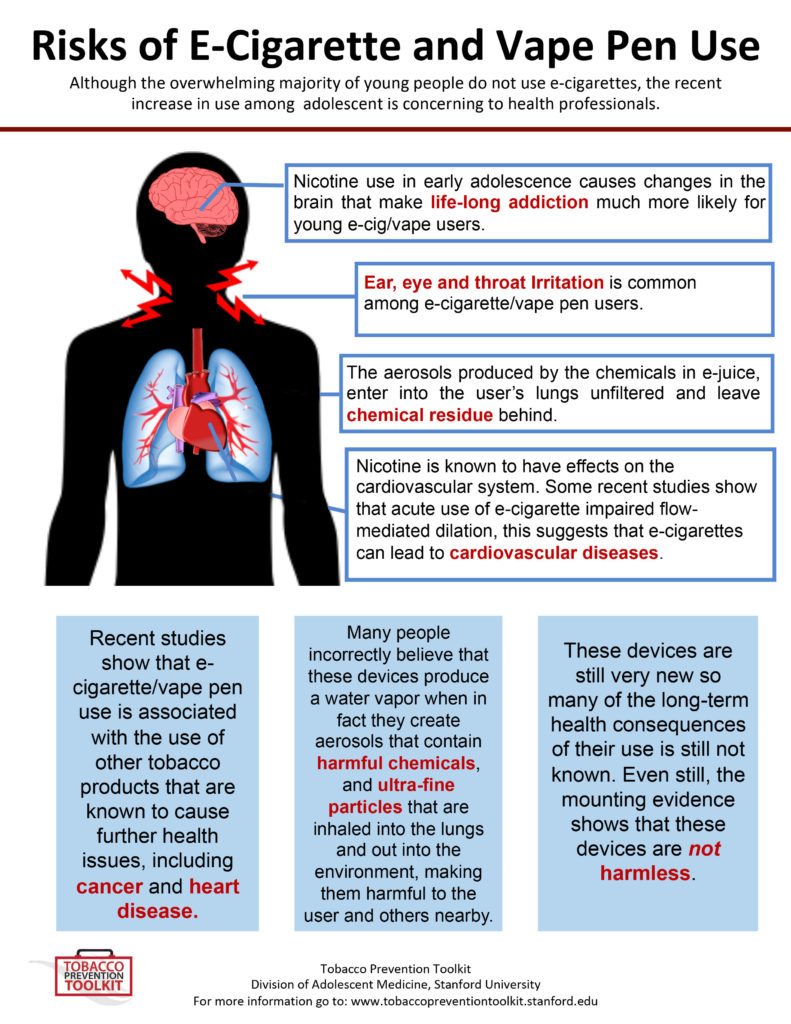
No, say the students in unison.
“Marketers don’t care about health risks,” says a student. “I think they only care about sales.”
As her science project, student Abigail Jauregui conducted a survey about vaping at her school. About half of the seventh graders she surveyed had tried it. Of these, only half knew there were dangerous chemicals in the vape liquid. The rest thought they were vaping flavored water.
“It was surprising,” says Abigail, who created anti-vaping posters for display on campus.
A student named Jorge admits being pressured by friends into trying vaping. He says Patterson has convinced him not to do it again.
“Vaping has been a big concern for me,” says Patterson. “I think it’s a big gateway to vaping marijuana or taking other drugs. Vaping nicotine interacts with a child’s brain to give them the feeling of being relaxed, which makes it easier to try something else.”
She encourages students to value their self-worth, to not be followers, and to educate their peers.
“Students have told me they use vaping for depression, relaxing, and to look cool,” she says. “I tell them we all experiment in life, but when something new comes about that looks fun and fantastic, you need to be cautious. Students need to practice how to say no if they feel pressured. They need to rely on real information instead of what their friends say.
“And we definitely need to begin educating children at an earlier age, starting in elementary school, along with parents.”
In addition to education about vaping, some schools actively monitor vaping activity, including installing vaping sensors in bathrooms. A few schools suspend offenders; others require they attend counseling sessions to help them quit. In San Francisco, Washington High School nurse and United Educators of San Francisco member Linda Boyer-Chu provides one-on-one counseling. Fremont Unified School District works with the city to have students attend four weekly evening counseling sessions, including one attended by parents.
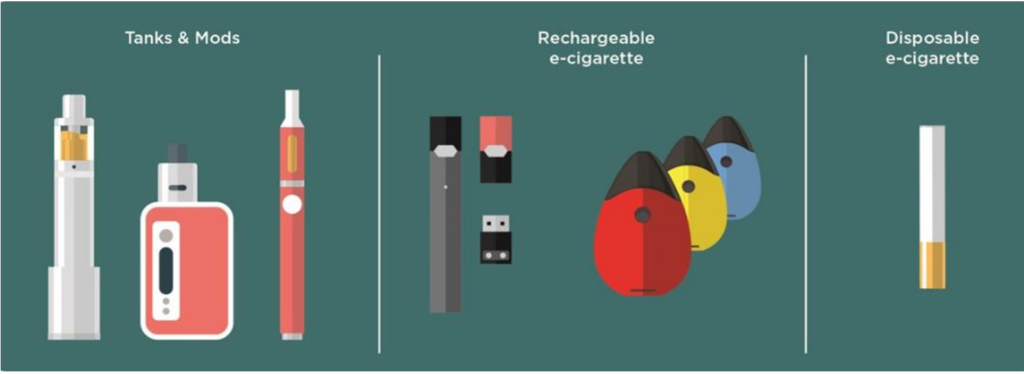
Getting Parents Involved
A joint effort to educate parents about vaping was undertaken by the Burbank Teachers Association and the Burbank Unified School District. The union and school district recently sponsored parent meetings at two high schools on the topic.

“Parents said, ‘Oh my goodness, this is wonderful,’ ” shares Burbank Teachers Association President Diana Abasta. “We see ourselves as having an important role in educating parents. We can’t just be concerned about kids in classes; we have to be concerned about them holistically, too.”
The collaboration was prompted after a representative from Breathe California Los Angeles contacted Abasta, offering to present information to parents for free.
“I thought it was fantastic, because we are really having an issue with vaping in our schools,” says Abasta. “I am proud BTA was involved in reaching out to the parent community about this.”

Christina Noriega, a counselor at William S. Hart High School in Santa Clarita, has worked to educate Spanish-speaking parents at her school about the student vaping epidemic.
“It’s a huge problem,” says Noriega, a member of Hart District Teachers Association. “When I read that one in five high school students is vaping, I decided we needed more parent education on the subject. I was surprised at how little information parents have.”
She found that parents were under the impression that e-cigarettes did not contain nicotine and were relatively safe. They were also surprised that vaping products look just like highlighters and flash drives. She shared warning signs a student may be vaping, including increased coughing, pneumonia, nose bleeds, dry skin and increased thirst.
“I try to empower parents on ways to start a conversation with their child about vaping instead of just lecturing,” says Noriega. “Seeing advertisements or seeing someone vaping may be the perfect opportunity to start that dialogue.”
“IT’S OUR JOB TO TEACH MATH, SCIENCE AND ENGLISH, BUT IT’S ALSO OUR JOB TO TEACH TO THE WHOLE STUDENT. AND THAT MEANS TEACHING ABOUT HEALTH RISKS.”
—Christina Noriega, Hart District Teachers Association
Some have questioned why it should be educators’ job to push back against vaping. Noriega says that given educators’ commitment to teach to the whole student, it makes sense.
“It’s our job as educators to teach math, science and English, but it’s also our job to teach to the whole student,” she says. “And that means teaching about health risks. Vaping affects what happens in the classroom because it affects students’ brains and prevents learning. It affects their overall health. If we don’t educate students and their families, who will?”
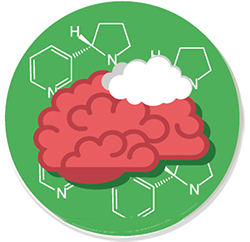
The Teen Brain & Nicotine
The brain keeps developing until about age 25. Using nicotine in adolescence can harm the parts of the brain that control attention, learning, mood and impulse control.
Each time a new memory is created or a new skill is learned, stronger connections — or synapses — are built between brain cells. Young people’s brains build synapses faster than adult brains. Nicotine changes the way these synapses are formed.
Using nicotine in adolescence may also increase risk for future addiction to other drugs. Source: Centers for Disease Control & Prevention
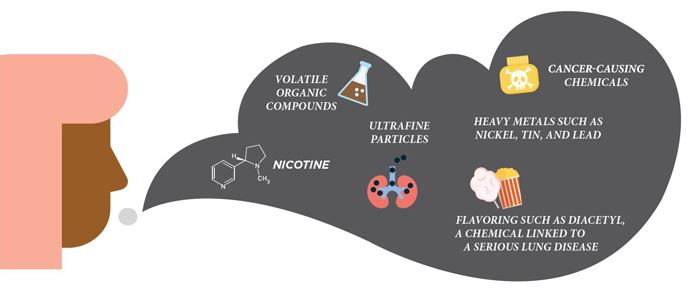
Teaching tools:
What you’re inhaling when you vape.
Vaping’s Victims
ON OCTOBER 1, the Centers for Disease Control and Prevention reported 1,080 lung injuries in people in 48 states and the Virgin Islands who vaped nicotine- or THC-related products. As we went to press, at least 23 deaths had been tied to vaping.
Investigation into the cause of the illnesses is ongoing. The majority (578) of those injured used devices with THC, and while the Food and Drug Administration has warned consumers to stop using THC vaping products, nicotine has not been ruled out as a cause. The CDC reported that most cases have involved young people in their late teens and 20s, and recommended that people stop using vaping products. Those who continue to do so should be aware of symptoms such as coughing, shortness of breath, chest pain, nausea and vomiting — and promptly seek medical attention for any health concerns.
Classroom resources:
Scholastic:
Lesson plan, worksheet and more
Stanford Medicine:
Comprehensive module, in five units, exploring e-cigarettes
American Lung Association:
Research, fact sheets
Breathe California:
Quick facts and Breathe LA: workshops for youth and adults
Centers for Disease Control:
Information, infographics, links to multiple resources
The Discussion 0 comments Post a Comment